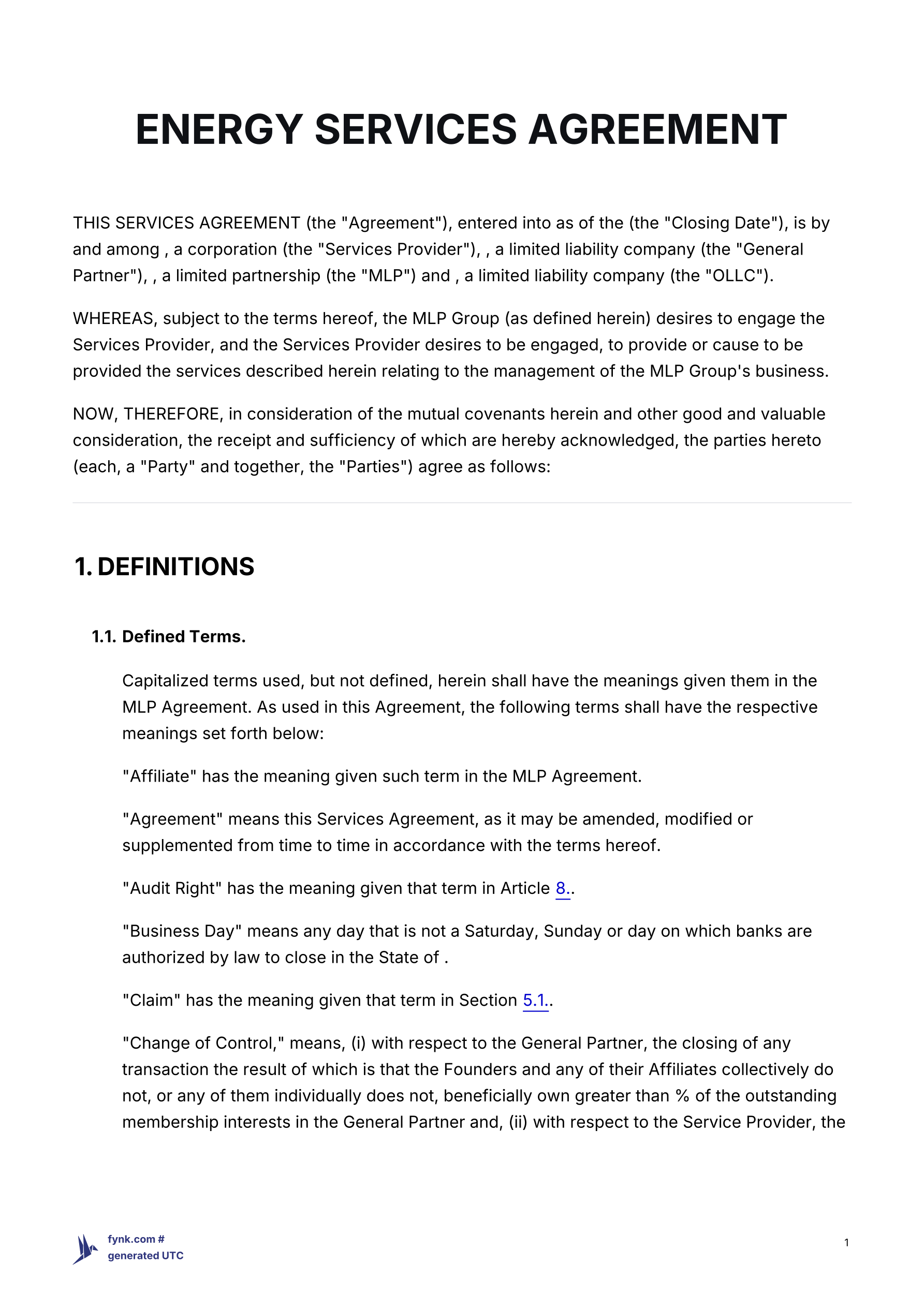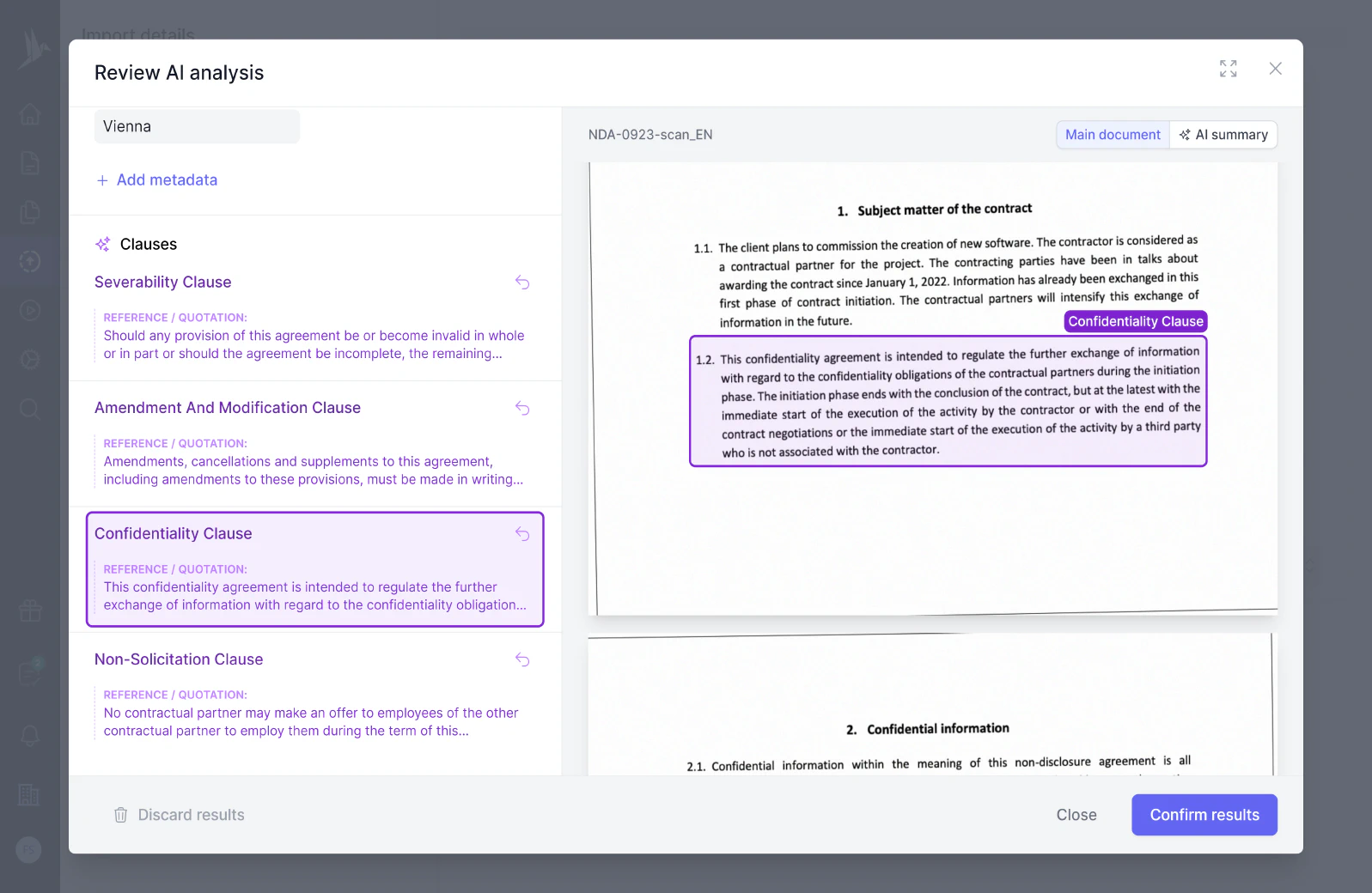
Energy Services Agreement Template
A clear energy services agreement template for engaging a service provider to manage operations, finance, and compliance.
A liability cap is a contractual provision that limits the maximum amount one party can be held financially responsible for in the event of a breach or other specified issues. This clause helps parties manage risk by capping potential financial exposure, promoting predictability and stability in contractual relationships.
Liability Cap - Subject to the IOU holding a valid ASC, a shareholder liability cap would limit the amount shareholders must pay for losses found to be imprudently incurred to 20% of the IOU’s Transmission and Distribution Equity Rate Base on a rolling three-year basis. These payments would be used to reimburse the Wildfire Fund.
The Liability Cap for SDG&E would be approximately $825 million based on its 2018 rate base and would adjust on a rolling three-year basis. The Liability Cap would apply so long as the fund has not been terminated, which could occur if funds are exhausted.
The Company hereby agrees that (i) the Guarantor shall in no event be required to pay an aggregate amount in excess of the Maximum Liability Cap under or in respect of the Guaranteed Obligations, and (ii) neither the Guarantor nor any Guarantor Affiliate (as hereinafter defined) shall have any obligation or liability to any Person including, the Company or its equity holders, relating to, arising out of or in connection with, this Limited Guarantee, the Commitment Letter or the Agreement, other than as expressly set forth herein or in the Commitment Letter. This Limited Guarantee may be enforced for the payment of money only. All payments hereunder shall be made in lawful money of the United States, in immediately available funds.
The Liability Cap is the total limit of the APS Parties’ aggregate liability for any and all claims or demands by anyone pursuant to this Agreement, including liability to the Company, to any other parties hereto, and to any others making claims relating to the work performed by APS pursuant to this Agreement. Any such claimants shall allocate any amounts payable by the APS Parties among themselves as appropriate, but if they cannot agree on the allocation it will not affect the enforceability of the Liability Cap. Under no circumstances shall the aggregate of all such allocations or other claims against the APS Parties pursuant to this Agreement exceed the Liability Cap. Notwithstanding the foregoing, the Liability Cap shall not limit the liability of APS from claims directly resulting from APS’ gross negligence, fraud, self-dealing or willful misconduct or other liabilities that cannot be disclaimed under applicable law.
“Remaining Liability Cap Amount” shall mean, on any date that amounts are due and payable pursuant to Article II(a) of the Parallel Guaranty, an amount equal to the positive difference, if any, between (i) the “Liability Cap” under and as defined in the Parallel Guaranty, but without regard to clauses (ii) and (iii) of such definition, and (ii) the amount due and payable pursuant to Article II(a) of the Parallel Guaranty (for the avoidance of doubt, giving effect to the “Liability Cap” under and as defined in the Parallel Guaranty).
The Purchase Agreement contains reasonable and customary representations and warranties relating inter alia to title in Target Companies shares, financial statements, the operative business, the IP and the IT landscape of the Target Companies as well as to tax. The Seller’s liability for claims under the Purchase Agreement except for fundamental warranties, tax claims and specific indemnities is capped to (i) 35% of the Cash Consideration (“Cash Liability Cap”) and (ii) 35% of the Share Consideration (“Share Liability Cap”), provided that claims shall first be settled in cash up to Cash Liability Cap and thereafter in shares in the Company at the Agreed Share Value up to the Share Liability Cap. The Seller’s overall liability under the Purchase Agreement is capped to 100% of the Cash Consideration and of the Share Consideration, first to be settled in cash and thereafter in shares.
Notwithstanding anything to the contrary contained in this Guaranty, Guarantor’s liability under this Guaranty shall not exceed a total of $22,300,000 (the “Guarantor Liability Cap”).
All (i) payments, repayments and prepayments of the outstanding Obligations by Borrower or any other Person and/or (ii) amounts realized from the Collateral and to be applied to the Obligations, shall, for purposes of this Section 2(e) be deemed to be applied first to the portion of the Obligations which exceeds the Guarantor Liability Cap and thereafter to the outstanding Obligations to reduce the Guarantor Liability Cap on a dollar-for-dollar basis.
“Liability Cap” means an amount equal to US$2,000,000 as reduced upon the completion of each 1-month period following the Closing Date by an amount equal to US$2,000,000 divided by 24, rounded to the nearest whole number; provided, that if any Damages are actually paid to a Buyer Indemnified Person in accordance a Claim for indemnification properly made under Article 6 hereof during the twenty-four (24) months following the date of Closing (and the Liability Cap is thus further reduced pursuant to Section 6.3 hereof), the aforementioned per-month reduction shall be reduced proportionally such that the Liability Cap remains above US$0 until such twenty-four (24) month period following the Closing has concluded. For illustration purposes, if US$500,000 is paid in Damages by the Indemnifying Party in respect of an indemnification Claim properly made by Buyer under Article 6 hereof in the first month following the Closing, for months 2 through 24 following the Closing, the per-month reduction of the Liability Cap shall be based upon the remaining Liability Cap amount after subtracting the full amount of the Claim made (for a remaining Liability Cap in this example of US$1,416,667) to be divided by the remaining amount of months (in this example, 23) rounded to the nearest whole number. In the event that a Claim that has been subtracted from the Liability Cap for purposes of the foregoing calculation, is resolved prior to the expiration of the aforementioned period of twenty-four months, and the total indemnification payment payable by the Indemnifying Party is lower than so subtracted, any difference between the subtracted amount and the amount actually payable by the Indemnifying Party shall be added to the total remaining Liability Cap amount and included in any further reductions. For the avoidance of doubt, if Closing occurs on August 30, the first reduction shall have occurred on the following September 30.
The Liability Cap is the total limit of the APS Parties’ aggregate liability for any and all claims or demands by anyone pursuant to this Agreement, including liability to the Company, to any other parties hereto, and to any others making claims relating to the work performed by APS pursuant to this Agreement. Any such claimants shall allocate any amounts payable by the APS Parties among themselves as appropriate, but if they cannot agree on the allocation it will not affect the enforceability of the Liability Cap. Under no circumstances shall the aggregate of all such allocations or other claims against the APS Parties pursuant to this Agreement exceed the Liability Cap.
Seller Aggregate Liability for Certain Events. (a) Notwithstanding any provision herein to the contrary, the maximum Seller Aggregate Liability as of any given date in respect of any occurrence or series of occurrences shall not exceed the Seller Liability Cap. (b) “Seller Aggregate Liability” shall mean, as of any date of determination, any and all liability of Seller to Buyer under this Agreement, excluding (i) any Seller liabilities under this Agreement for which Seller has already made payment to Buyer as of such date, (ii) any liability caused by the gross negligence or willful misconduct of Seller or any Affiliate of Seller, and (iii) any liability of Seller pursuant to Section 25. (c) The “Seller Liability Cap”, as of any given time of determination, shall be an amount (in USD) equal to USD [***] (US$[***]).
Buyer Liability Cap. (a) Notwithstanding any provision herein to the contrary, the maximum Buyer Aggregate Liability as of any given date in respect of any occurrence or series of occurrences shall not exceed the Buyer Liability Cap. (b) “Buyer Aggregate Liability” shall mean, as of any date of determination, any and all liability of Buyer to Seller under this Agreement, excluding (i) any Buyer liabilities under this Agreement for which Buyer has already made payment to Seller as of such date, (ii) any liability caused by the gross negligence or willful misconduct of Buyer or any Affiliate of Buyer, (iii) any amounts related to the indemnity obligation of Buyer set forth in Section 7.7.1, and (iv) any liability of Buyer pursuant to Section 25. (c) The “Buyer Liability Cap”, as of any given time of determination, shall be an amount (in USD) equal to USD [***] (US$[***]).
A Liability Cap is a contractual clause that limits the amount one party can claim from another in the event of a loss or damage resulting from a breach of contract or negligence. This ceiling on potential liability provides predictability and financial security to both parties involved in the contract.
You should consider using a liability cap in the following situations:
Contractual Negotiations: When entering contracts where there is significant risk of loss or damage, it is vital to manage potential liabilities.
Risk Management: For businesses engaging in projects with high uncertainty or where the potential for substantial claims exists, a liability cap can mitigate vast financial exposure.
Cost Control: When the cost of insuring against unlimited liability is too high, a liability cap provides a more controllable means of managing risk.
Partnerships and Collaborations: In joint ventures or partnerships where each entity brings different risk levels, a liability cap can align risk with the expected level of involvement.
When drafting a liability cap clause, consider the following elements:
Define the Cap: Specify the maximum amount that can be claimed. This can be a fixed sum or a percentage of the contract value.
Example: “The total liability of [Party] for all claims arising under or related to this agreement shall not exceed $500,000.”
Scope of the Cap: Clearly define which liabilities are covered by the cap. This could include negligence, breach of contract, or specific types of damages.
Example: “This liability cap applies to all liabilities arising from errors, omissions, or breaches of this contract.”
Excluded Liabilities: Identify any liabilities not subject to the cap, such as those resulting from gross negligence or willful misconduct.
Example: “The liability cap shall not apply to liabilities arising from fraud or intentional wrongdoing.”
Adjustment Clause: Consider including a provision for adjusting the cap based on project changes or inflation.
Example: “Liability limits may be adjusted annually based on the Consumer Price Index.”
Agreement of Both Parties: Ensure that both parties agree to the terms of the liability cap, which should reflect a negotiated balance of risks.
Liability caps are commonly found in the following types of contracts:
Services Agreement: To limit service provider’s liability for service failures.
Supply Contracts: To protect suppliers from extensive liability for product defects or delivery failures.
Construction Contracts: To manage risks associated with delays and defects in large-scale projects.
IT and Software Contracts: To limit liability for faults in software or IT service delivery.
Consulting Agreements: Consultants often use liability caps to limit exposure from professional advice or recommendations.
By including a liability cap in relevant agreements, parties can better manage risk, reduce uncertainty, and facilitate a more balanced and predictable contractual relationship.
These templates contain the clause you just read about.

A clear energy services agreement template for engaging a service provider to manage operations, finance, and compliance.

A template for companies to indemnify directors and officers against claims arising from their service, with clear terms on scope and payment timing.

A clear revenue sharing agreement template that defines terms, percentages, and payment structures between two parties.

A comprehensive sponsorship agreement template outlining rights, benefits, fees, and obligations between a professional sports team and a sponsor.
Dive deeper into the world of clauses and learn more about these other clauses that are used in real contracts.
A liability disclaimer is a contractual clause designed to limit or waive one party's legal responsibility for certain damages or losses that may arise from the agreement. It serves to protect the disclaiming party from lawsuits or claims by specifying the risks that the other party assumes upon entering into the contract.
A "Liability for breach of contract" clause outlines the responsibilities and obligations a party faces if they fail to fulfill their contractual duties, including potential compensation for damages incurred by the non-breaching party. It typically specifies the extent and limitations of liability, such as caps on damages or exclusions of certain types of loss.
A "license back" clause grants the original owner of intellectual property some rights to use or exploit improvements made to that property by a licensee. This allows the licensor to benefit from enhancements or developments made by the licensee during the term of the license agreement.
Try our AI contract analysis and extract important clauses and information from existing contracts.
< <
Fill out the form and we will get in touch with you to give you a personal, customized demo of fynk.
Greetings!
I'm Markus, co-founder of fynk. After you've submitted the form, I'll swiftly get in touch with you.
Also, right after you submit your details, you can pick a time that works best for you for our meeting.

